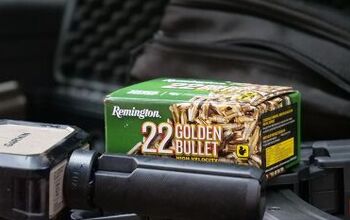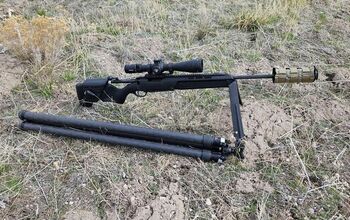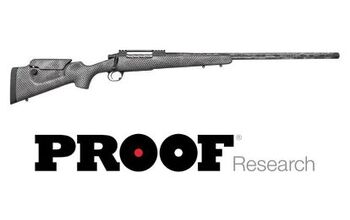Brief History Of The Soviet 6mm Program

There is always a desire to improve and address current and future threats. Enhancing the self-contained metallic cartridge and projectile is essential to meet evolving operational demands and effectively counter emerging threats. By focusing on performance improvements, we can increase lethality, and the Soviet Union tried to do this from the mid-1970s to the mid-1990s, possibly around 2015.
The Soviet decision to develop a 6mm cartridge was first finalized in 1975. The research and development program NV5-124-75 was initiated to find the optimal 6mm caliber for a new rifle cartridge. This started with a little-known 6mm VSS (ВСС), which is a 6x53mm cartridge that shared its parent case from the 10/3.5mm VSL-1 flechette case; the 6x53mm also featured an 84.8 grain (5.5 gram) projectile. This cartridge slugged it out with the Soviet equivalent of the US Special Purpose Individual Weapon (SPIW) program; however, the Soviets did develop a flechette shooting PKM called the PKG (6P6-10), so, of course, this has my attention. This 6x53mm VSS was in development from 1975 to around 1982. In 1981, this cartridge was redesigned and developed into a new cartridge, the 6mm VSZ/1/M (ВСЗ) 6x49mm. The cartridge was designed at TSNIITochMash, a government-owned research and manufacturing organization in Klimovsk, near Moscow, specializing in small arms and ammunition development.
The goal was to create a modern ammunition that would offer a longer effective range, reduced weight by 40%, and recoil by 25 %. This cartridge was close to being adopted, as the development of different projectiles such as B-32 type tungsten core armor-piercing incendiary (realistically, the current 7.62x54 B-32 leaves much to be desired at its quasi-AP). I found little information from the available data on the 6x49mm VSZ, a near straight-wall cartridge design. Then, the latter version of the cartridge design featured a groove or channel near the base of the case to address a problem they ran into, which was reliable extraction. So, a pressed groove was added to address this issue.
The annular groove, located near the bottom of the cartridge, compensates for the deformation of the cartridge's base by straightening the groove and filling the chamber when fired. It can address minor headspacing issues like mismatched spare machine gun barrels.
During firing, the case does not expand; instead, the annular groove is displaced, straightening the partially rolled edges. Thin cartridge walls ensure the obturation of powder gases. This design allows for a significant increase in the strength and elasticity of the case walls and the base, which allows reliable extraction.
The gunpowder was no ordinary loose propellant powder but compressed high-density small granules. This was needed to get the necessary volume of power in the cartridge. Around the mid to late 1980s, there was a switch in propellant to commercial off-the-shelf propellant, possibly moving away for a cheaper alternative as things were getting rough in the Soviet Union. This led to the development of a longer cartridge case designed to accommodate the propellant for the VS6 6x57mm cartridge, which has an initial speed of 3,674 to 3,772 fps (1,120 to 1,150 m/s). The annular groove was also incorporated into the VS6/1/M (BC6) 6x57mm cartridge, which underwent experiments with and without these grooves. However, the 6x57mm cartridge was short-lived and eventually fell out of favor, while the 6x49mm cartridge remained the primary focus of interest.
The new machine guns and rifle cartridges had 40% less weight and an impressive ballistic performance, significantly exceeding this figure for the 7.62x54mm cartridge. The weapons using the new cartridge have a quarter-reduced recoil, which, together with increased velocity, makes it attractive for use in sniper rifles and machine guns.
There are at least three different machine guns that I have seen and could research further. These include the 6mm VSS 6x53 TKB-1050 and the 6mm VS6 6x57 TKB-1070, which I saw at the Tula Arms Museum. The third one was the 6mm VSZ 6x49 AO-64M, and I saw a 6mm PKM at the Kalashnikov Museum years ago. However, it has since been replaced by a standard PKM. Very little information is available about the machine gun chambered for 6x49mm. Still, it has outperformed the PKM regarding range and accuracy while reducing the ammunition's weight.
These developments were mostly suspended with the collapse of the Soviet Union, but 6x49 was said to have been displayed in 1994 at the defense exhibition Milipo-94 near Moscow. Further research was required, which was impossible to conduct with a sharp reduction in funding. The 6mm program overlapped a difficult time with the collapse of the Soviet Union, which drastically reduced research and development for something that wasn’t necessary and a priority in such a tumultuous time
Even with the collapse of the Soviet Union nearing, developers at TSNIITochMash created the 6x49mm cartridge in the late 1980s. This cartridge features a rimless, bottlenecked steel design, is loaded with a bullet weighing 77 grains (5 grams), and delivers muzzle velocities of 3,608 to 3,772 fps (1,100 to 1,150 m/s). This cartridge received the designation Unified Cartridge, which aimed to standardize ammunition across various weapons on one cartridge. At least one machine gun, the AO-64/M, received the designation Unified machine gun.
TSNIITochMash manufactured several 6mm Unified machine guns before the dissolution of the Soviet Union, which ended the whole 6mm Unified program around 1996. The 6mm AO-64 had an effective range of up to 1,500 meters and was supersonic out to 1,150m. This performance would have made it an impressive machine gun in every role, especially on a tripod operating in a gun team, providing support by fire. The ability to deliver overmatch capability enhances the unit's operational capability.
The 6mm AO-64M machine gun is a gas-operated weapon with an open bolt. It has a quick-detachable, air-cooled barrel with a rotating bolt. This gun uses a proprietary push-through, non-disintegrating steel belt. It is fitted with a wooden shoulder stock of skeletonized design for the gunner's support hand, pistol grip, and folding bipod. With such a short receiver, the charging handle is attached to the left side of the piston tube. The designers also incorporated an integral sight built into the top of the feed tray cover. Some prototypes featured an active cooling system forward of the gas block that pulled air through four channels under a barrel jacket to improve heat mitigation and service life. This feature was patented in 1996 under Patent RU 2067276 C1, indicating that development of the AO-64M continued at least until 1996.
In the late 1980s, one of the sniper rifles developed was the Izhmash SVK, which was designed for the 6x49mm cartridge and outperformed the SVD 2.3 times. This resulted in a significantly flat shooting weapon, nearly doubling the SVD's effective range and accuracy.
Despite its improved performance, the 6x49mm cartridge had significant drawbacks. One of the most notable issues was its tendency to cause rapid barrel wear, leading to excessive heat and erosion. Reports indicated that barrels could wear out after only 5,000 to 6,000 rounds, roughly one-third of the expected lifespan of conventional cartridges like the 7.62x54. In contrast, modern machine guns using standard ammunition typically have a service life of at least 15,000 rounds or more. This high wear rate made the 6x49mm less appealing for military applications, particularly in durability and longevity. However, chatter since 2015 may indicate renewed interest, especially with advancements in metallurgy and the development of new barrel liners. Notably, a Russian patent, RU 2647948 C2, emerged around the same time for a ceramic-lined machine gun barrel. However, this is only one solution, as there are many different approaches to address this issue, depending on the development budget and its economic viability for Russia.
Thoughts
The Soviet 6x49mm cartridge is an intriguing round that has gained renewed interest since the US Army's Next Generation Squad Weapons (NGSW) program began around 2017. Logistically, introducing a new caliber like the 6x49mm would have posed significant challenges, as the Soviets have experienced twice since World War II. Although the 6x49mm demonstrated impressive ballistics—with a high muzzle velocity and solid accuracy at extended ranges—it ultimately failed to attract enough interest from decision-makers.
The limitations in metallurgy during that period posed significant challenges; however, solutions have since been developed to address barrel wear. Ceramic-lined barrels can endure higher temperatures, improving wear resistance and extending the barrel's life. The 6x49's lighter ammunition load and enhanced ballistic performance make it an appealing option.
Russia's failure to recognize the potential improvements this could bring to infantry capability and lethality may put them at a disadvantage, especially since the US and NATO partners are exploring new cartridges. As a result, this may have already influenced the Russian Ministry of Defense to reconsider its 6mm program. This situation has been complicated, as in 2023, Russia adopted a new rifle chambered in 7.62x54, known as the SVCh.
Sources:
- https://vk.com/doc41072062_212832649?hash=zhjVpmfuJ057EUbeTV2m3fcJoZTc9D1cHUjyLK8mqCs&dl=OWg5LzJYh8Pan0rzxQT7ecHTjgnB3SXR0pzYpdEbBcT&api=1&no_preview=1
- CARTRIDGES SMALL ARMS 1980 by V. Min KIRILLOV, V. Min SABELNIKOV
- Book 4 LIVE CARTRIDGES of small arms MODERN DOMESTIC CARTRIDGES Chronicles of designers V.N.Dvoryaninov

Lynndon Schooler is an open-source weapons intelligence professional with a background as an infantryman in the US Army. His experience includes working as a gunsmith and production manager in firearm manufacturing, as well as serving as an armorer, consultant, and instructor in nonstandard weapons. His articles have been published in Small Arms Review and the Small Arms Defence Journal. https://www.instagram.com/lynndons
More by Lynndon Schooler





















![[SHOT 2025] First Look At The REVIVED P7 Squeeze-cocker From P7Pro](https://cdn-fastly.thefirearmblog.com/media/2025/01/25/18541/shot-2025-first-look-at-the-revived-p7-squeeze-cocker-from-p7pro.jpg?size=350x220)






![[SHOT 2025] B&T Guns, Silencers, and More](https://cdn-fastly.thefirearmblog.com/media/2025/02/01/023216/shot-2025-b-t-guns-silencers-and-more.jpg?size=350x220)







Comments
Join the conversation
The projectile weight of 77 grains seems a bit light for long range shooting. I would have expected them to use at least 100 grains or more.
Those ceramic barrels sound like the future. Thanks for sharing.